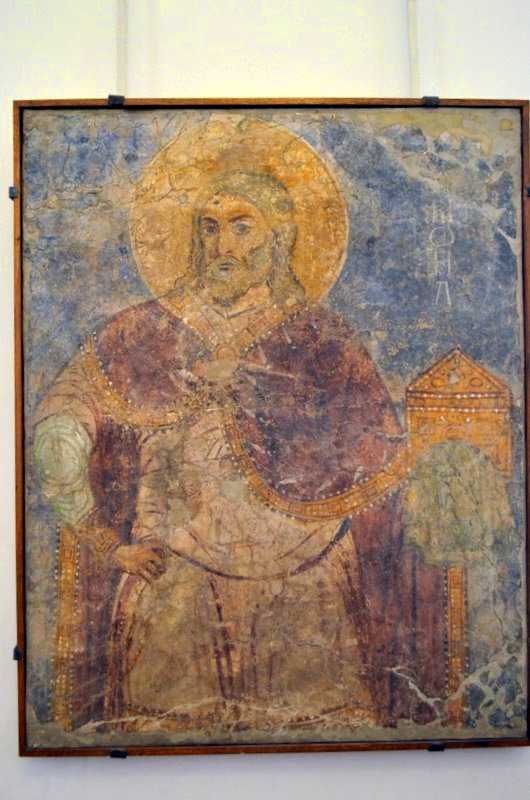In 2012, Terry and I spent a week in St. Petersburg, Russia, visiting my brother and exploring the northern capital of the country. Below are a few pictures.
 |
| St. Peterburg sign at the entrance of the city |
The Church of the Savior on Spilled Blood
The Church of the Savior on Spilled Blood (Khram Spasa na Krovi - Russian) is one of the main sights of St. Petersburg, Russia. It is also variously called the Church on Spilt Blood and the Cathedral of the Resurrection of Christ.
This Church was built on the site where Tsar Alexander II was assassinated and was dedicated in his memory. The construction of the church was almost entirely funded by the Imperial family and thousands of private donators. Both the interior and exterior of the church is decorated with incredibly detailed mosaics, designed and created by the most prominent Russian artists of the day (V.M. Vasnetsov, M.V. Nesterov and M.A. Vrubel). The church was closed for services in the 1930s, when the Bolsheviks went on an offensive against religion and destroyed churches all over the country. It remained closed and under restoration for over 30 years and was finally re-opened in 1997 in all its dazzling former glory.
Russian Cruiser Aurora
Aurora is a 1900 Russian protected cruiser, currently preserved as a museum ship in St. Petersburg. She battled the Japanese Navy in the Russo-Japanese War. One of the first incidents of the October Revolution happened here.
Winter Palace
The earliest and most celebrated building on the square is the baroque white-and-azure Winter Palace of Russian tsars (1754–62), which gave the square its name. Palace Squate is the main square in Petersburg and of the former Russian Empire. It was the setting of many events of worldwide significance, including the Bloody Sunday (1905) and the October Revolution of 1917.
Alexander Column is located in the center of Winter Palace square (1830–34), designed by Auguste de Montferrand. This red granite column (the tallest of its kind in the world) is 47.5 metres high and weighs some 500 tons.
St Isaak Cathedral
Saint Isaac's Cathedral or Isaakievskiy Sobor is the largest Russian Orthodox cathedral in the city. It is dedicated to Saint Isaac of Dalmatia, a patron saint of Peter the Great, who had been born on the feast day of that saint. The design of the cathedral in general and the dome in particular later influenced the design of the United States Capitol in Washington, D.C.
 |
| Interior |
The cathedral's main dome rises 101.5 metres (333 ft) and is plated with pure gold.
Internal features such as columns, pilasters, floor, and statue of Montferrand are composed of multicolored granites and marbles gathered from all parts of Russia.
 |
| The iconostasis is framed by eight columns of semiprecious stone: six of malachite and two smaller ones of lazurite. |
The interior was originally decorated with scores of paintings by Karl Bryullov and other great Russian masters of the day. When these paintings began to deteriorate due to the cold, damp conditions inside the cathedral, Montferrand ordered them to be painstakingly reproduced as mosaics, a technique introduced in Russia by Mikhail Lomonosov.
Kazan Cathedral
Kazan Cathedral is a cathedral of the Russian Orthodox Church on the Nevsky Prospekt. It is dedicated to Our Lady of Kazan, probably the most venerated icon in Russia.
The cathedral's interior, with its numerous columns, echoes the exterior colonnade and is reminiscent of a palatial hall, being 69 metres in length and 62 metres in height. The interior features numerous sculptures and icons created by the best Russian artists of the day. A wrought iron grille separating the cathedral from a small square behind it is sometimes cited as one of the finest ever created.
Russian Museum
The State Russian Museum is the largest depository ofRussian fine art in Saint Petersburg.
The museum was established on April 13, 1895, upon enthronement of Nicholas II to commemorate his father, Alexander III. Its original collection was composed of artworks taken from the Hermitage Museum, Alexander Palace, and the Imperial Academy of Arts. After theRussian Revolution of 1917, many private collections were nationalized and relocated to the Russian Museum. These included Kazimir Malevich's Black Square.
 |
| Catherine the Great |
 |
| Henryk Siemeradzki "Phrime at the Festival of Poseidon at the Eleusinia" |
Useful links and sources:















